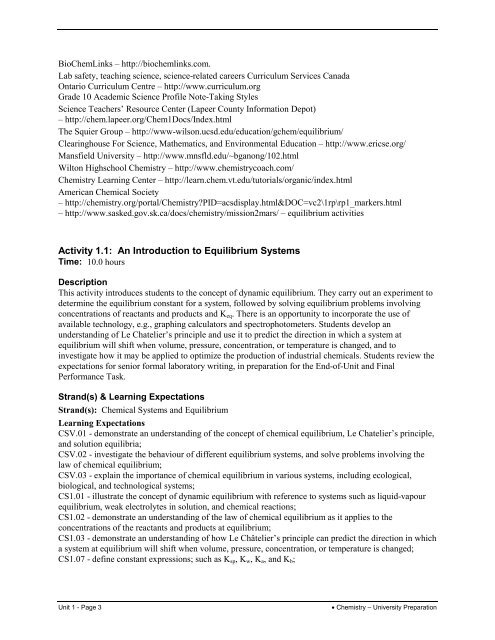Course Profile - Curriculum Services Canada
Course Profile - Curriculum Services Canada
Course Profile - Curriculum Services Canada
You also want an ePaper? Increase the reach of your titles
YUMPU automatically turns print PDFs into web optimized ePapers that Google loves.
BioChemLinks – http://biochemlinks.com.<br />
Lab safety, teaching science, science-related careers <strong>Curriculum</strong> <strong>Services</strong> <strong>Canada</strong><br />
Ontario <strong>Curriculum</strong> Centre – http://www.curriculum.org<br />
Grade 10 Academic Science <strong>Profile</strong> Note-Taking Styles<br />
Science Teachers’ Resource Center (Lapeer County Information Depot)<br />
– http://chem.lapeer.org/Chem1Docs/Index.html<br />
The Squier Group – http://www-wilson.ucsd.edu/education/gchem/equilibrium/<br />
Clearinghouse For Science, Mathematics, and Environmental Education – http://www.ericse.org/<br />
Mansfield University – http://www.mnsfld.edu/~bganong/102.html<br />
Wilton Highschool Chemistry – http://www.chemistrycoach.com/<br />
Chemistry Learning Center – http://learn.chem.vt.edu/tutorials/organic/index.html<br />
American Chemical Society<br />
– http://chemistry.org/portal/Chemistry?PID=acsdisplay.html&DOC=vc2\1rp\rp1_markers.html<br />
– http://www.sasked.gov.sk.ca/docs/chemistry/mission2mars/ – equilibrium activities<br />
Activity 1.1: An Introduction to Equilibrium Systems<br />
Time: 10.0 hours<br />
Description<br />
This activity introduces students to the concept of dynamic equilibrium. They carry out an experiment to<br />
determine the equilibrium constant for a system, followed by solving equilibrium problems involving<br />
concentrations of reactants and products and K eq . There is an opportunity to incorporate the use of<br />
available technology, e.g., graphing calculators and spectrophotometers. Students develop an<br />
understanding of Le Chatelier’s principle and use it to predict the direction in which a system at<br />
equilibrium will shift when volume, pressure, concentration, or temperature is changed, and to<br />
investigate how it may be applied to optimize the production of industrial chemicals. Students review the<br />
expectations for senior formal laboratory writing, in preparation for the End-of-Unit and Final<br />
Performance Task.<br />
Strand(s) & Learning Expectations<br />
Strand(s): Chemical Systems and Equilibrium<br />
Learning Expectations<br />
CSV.01 - demonstrate an understanding of the concept of chemical equilibrium, Le Chatelier’s principle,<br />
and solution equilibria;<br />
CSV.02 - investigate the behaviour of different equilibrium systems, and solve problems involving the<br />
law of chemical equilibrium;<br />
CSV.03 - explain the importance of chemical equilibrium in various systems, including ecological,<br />
biological, and technological systems;<br />
CS1.01 - illustrate the concept of dynamic equilibrium with reference to systems such as liquid-vapour<br />
equilibrium, weak electrolytes in solution, and chemical reactions;<br />
CS1.02 - demonstrate an understanding of the law of chemical equilibrium as it applies to the<br />
concentrations of the reactants and products at equilibrium;<br />
CS1.03 - demonstrate an understanding of how Le Châtelier’s principle can predict the direction in which<br />
a system at equilibrium will shift when volume, pressure, concentration, or temperature is changed;<br />
CS1.07 - define constant expressions; such as K sp , K w , K a , and K b ;<br />
Unit 1 - Page 3<br />
• Chemistry – University Preparation
















